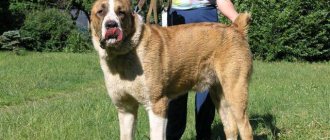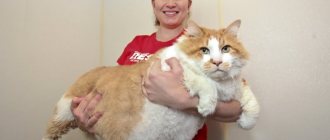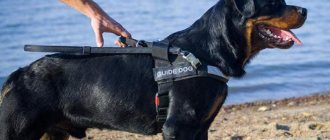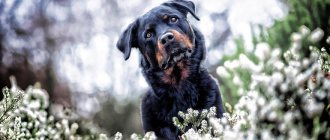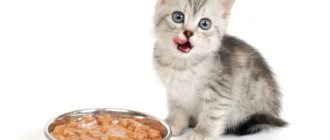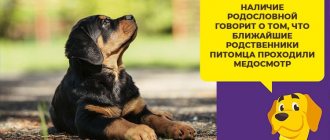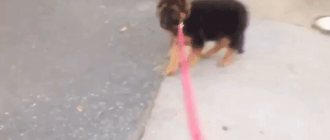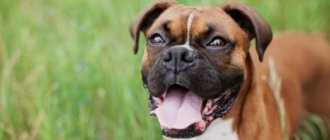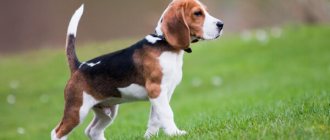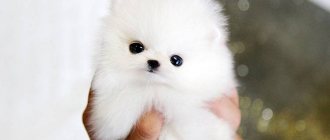History of the breed
The history of the origin of the family largely determined the unpredictable nature of the Rottweiler breed.
The starting point is the period of the Roman conquests of Germany, when Molossians, the distant ancestors of modern Rottweilers, came to Western Europe along with legionnaires. The dogs stood out with their massive, powerful bodies and strong jaws. The colonialists settled on the captured German lands and took up livestock farming. Here, Molosser dogs showed themselves in all their glory: they took the herds out for grazing, returned them to the pen, and protected them from wild animals.
Over time, there was not a farm left in Germany where such formidable and reliable “shepherds” were not used. But the idea to develop a new type of dog based on Molossians appeared only in the middle of the 18th century. Farmers in the town of Rottweil needed disciplined dogs with transport skills. Without thinking twice, the peasants took a local German Shepherd and crossed a Roman Molosser with it. The resulting offspring were named in honor of their small historical homeland.
Thus began the history of the Rottweiler breed as an independent species. Grown-up dogs were used as transporters of meat products. Local farmers supplied many surrounding principalities with meat, and there were no reliable logistics routes between the regions in those days. Powerful, hardy, menacing-looking dogs did an excellent job of transporting meat carcasses and protecting food from the attacks of road robbers. Many dogs did this type of work, earning the breed the nickname "Metzgerhund" (butcher's dog).
The proximity to the carcasses of livestock smelling of blood, and the attitude of not letting anyone near the cart with meat, played an important role in shaping the character of the dogs. The developed skills have formed a genetic code that is passed on within this species from generation to generation. In many ways, it was these habits that influenced the fact that the Rottweiler dog usually receives a less flattering description of its character.
The situation was changed by the construction of the railway passing through Rottweil. Soon, farmers completely switched to delivering goods by train, so the need for transport dogs disappeared. The former popularity of Rottweilers quickly faded away.
A happy accident brought back interest in the breed: one dog helped a policeman deal with a whole gang of hooligans. All the newspapers immediately trumpeted about the hero, thanks to which the Germans decided to use these animals as police service dogs. Rottweilers began to be bred again and trained as puppies for guard work. The dogs served excellently, for which they were loved by the general public.
In 1914, German Rottweilers were brought to Russia, where at first the dogs' mission was to drive livestock and fight wild animals. But domestic dog handlers became actively interested in the breed much later – during Stalin’s times. The breeders' task was to breed especially tough dogs that would escort and guard prisoners. The prototype was taken from Rottweiler dogs, famous for their power and guard skills. Breeders managed to develop a species with increased aggressiveness, but they were used only in special camps.
The first pet was a Rottweiler brought to Russia from Germany. He came from a branch with a balanced, fairly friendly disposition. Such a protector looked more like a reliable companion than a strict supervisor - this change marked the beginning of the popularity of Rottweilers in the USSR, and then in Russia.
Related article:
Dangerous dog breeds - lists of the TOP 10 breeds abroad and in Russia . Rottweiler, the characteristics of the breed are very versatile, read in a separate article where this breed ranks on the list of dangerous breeds.
Rottweiler dog - characteristics of the breed in brief
It’s hard to talk about such a controversial breed in a nutshell. Nevertheless, we will try to highlight the main qualities of these representatives of the Canine (Canidae) family.
The breed was developed in Germany in the mid-18th century. The height of an adult is from 56 to 68 cm, weight is 42-50 kg. At the same time, the Rottweiler male is more massive, taller and heavier than the female. These animals reach full maturity at the age of two; the average lifespan of an individual is 11-12 years.
To release energy, dogs of this breed need long walks with games and a sufficient amount of physical activity. Cold weather is tolerated, because... The body is warmed by a dense undercoat. But when the weather is too hot, the Rottweiler dog languishes from stuffiness. The breed has an enormous appetite, so you need to monitor the size and caloric content of portions, otherwise a fit dog will quickly become fat.
Rottweilers have extremely high mental abilities, thanks to which they are highly trained and can instantly find a solution to a problem. However, these geniuses require strict training from a very early age. The owner of such a dog must be powerful, experienced, and able to properly build a relationship with the pet. “Green” beginners should not even think about buying such a puppy. Without professional training, the dog will become uncontrollable and dangerous to people.
These are the main facts about Rottweilers, but these dogs really are too versatile. To understand even a little the riot of their feelings and emotions, a more thorough analysis of the characteristics will be required. Therefore, we invite you to further reading!
Appearance standard
In order for a boy or girl puppy to be recognized as a purebred puppy, its appearance must meet certain requirements. The international standard describes the characteristics of the Rottweiler breed as follows:
- Body type. The type is athletic, large, powerful. The body is squat, conducive to high stability. There is a clear sexual dimorphism: males are taller, heavier and slightly looser in constitution than females.
- Coat. Homogeneous, thick. The guard hair is coarse, for the most part characterized by medium length, but on the back and nape it is somewhat elongated, sometimes wavy. The undercoat is short, padded, compacted.
- Color. The standard is black coat color with brownish-red markings. They should have clear outlines and cover 15-30% of the body area. The main locations of tan marks are: chest, legs, throat, cheekbones and area near the eyes. The Golden Rottweiler dog (a rare species with completely red hair) is not recognized as a purebred dog, since such individuals are mestizos.
- Leather. Smooth, fit, no wrinkles allowed.
- Ears. Hanging, medium size and triangular in shape. Set high and wide.
- Head. Moderately large and long. The forehead is wide and convex. The transition to the muzzle is distinct, the cheekbones are expressive and emphasized.
- Eyes. Oval or round in shape, medium-sized. The iris is brown, the color of the eyelids is black. The brow ridges are voluminous.
- Muzzle. Smooth, wide, but gradually tapering at the bow. The bridge of the nose of a Rottweiler dog is straight, the lobe is black and wide, and the nostrils are large. The lips are fleshy, loose, tightly compressed, but with slightly drooping corners. Black color. The jaws are strong and massive, the type of bite is scissor, the number of teeth is 42.
- Neck. Set high, moderately long, strong. The relief of the muscles is clearly visible.
- Frame. The back is straight, the loin is dense, the croup is wide and rounded. Muscular relief along the spine is desirable. The chest is massive, spacious, deep. The transition from the ribs to the stomach is invisible. An overly stretched body is a distinctive characteristic of a Rottweiler bitch (for males it is considered a flaw).
- Limbs. Wide set, muscular. The front legs are straight, with developed forearms and pasterns. The hindquarters are slightly set back from the body, the hips are large, and the angle of the hock joint is smooth. The paw is dense, round in shape, as if clenched into a fist. Fingers are short.
- Tail. Elongated, thickened at the base. Cupping is optional.
Here is a standard description of what a Rottweiler dog with a purebred pedigree looks like. It is worth adding that when in a relaxed state, the gait of these animals looks lazy and slack. But while performing the task, the dogs demonstrate strong, purposeful and confident paw movements.
Puppy: sizes by month from 1 to 12 months (table)
| Puppy age | Puppy weight (boy/girl) | Puppy height (boy/girl) |
| 1 month | 3.5/4.5 kg | 20/22 cm |
| 2 months | 8/9 kg | 33/29 cm |
| 3 months | 17/14 kg | 47/48 cm |
| 4 months | 23/17 kg | 51/51 cm |
| 5 months | 31/24 kg | 56/56 cm |
| 6 months | 35/30 kg | 60/59 cm |
| 7 months | 40/34 kg | 64/61 cm |
| 8 months | 46/36 kg | 66/62 cm |
| 9 months | 50/36 kg | 66/62 cm |
| 10 months | 50/36 kg | 67/63 cm |
| 11 months | 50/38 kg | 67/63 cm |
| 12 months | 50/40 kg | 67/63 cm |
Owners of Rottweiler puppies should remember that this table shows the average and considered ideal size and weight of the dog..
It is advisable to strive for these parameters, but if the puppy does not meet them a little, do not worry about it.
After all, what is much more important is not how much a pet weighs and how tall he is at the withers - as long as he is within the standard, but how cheerful, healthy and active he is.
And if we are talking about small puppies, then you need to remember that each dog is an individual and there is nothing wrong with the fact that some of them grow faster, while others grow slower.
Growth and development of a puppy by month
1 month
In order not to harm the fragile baby, it is necessary to competently approach the choice of products and diet. At this age, mother's milk will be quite sufficient, provided that the bitch consumes the required amount of vitamins and minerals. At this point, the puppy’s height at the withers will be 20–22 cm, and its weight will be from 3.5 to 4.5 kg.
2 months
At 2 months, the puppy should try raw meat for the first time, which must be cut into small pieces (it will be very difficult for him to chew a large piece). At this time, it is time to include fermented milk products, as well as eggs, vegetables and cereals in the diet.
The baby should eat 6 times a day. Per day, the pet should receive:
- at least 200 grams of meat;
- 400 milliliters of milk;
- 100 grams of porridge;
- 150 grams of cottage cheese and the same amount of vegetables.
